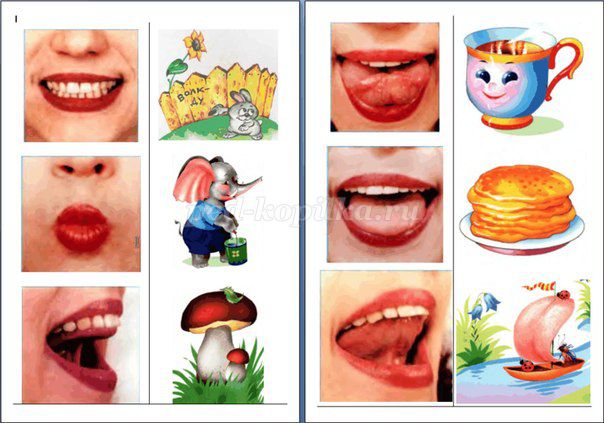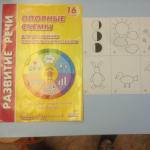Split file of articulation gymnastics for kindergarten
Articulation gymnastics
Speech sounds are formed as a result of a complex set of movements of articulatory organs - kinem. The development of this or that kinema opens up the possibility of mastering those speech sounds that could not be pronounced due to its absence. Thus, the pronunciation of speech sounds is a complex motor skill.
For clear articulation, strong, elastic and mobile organs of speech are needed - tongue, lips, palate. Articulation is associated with the work of numerous muscles, including: chewing, swallowing, mimic. The process of voice formation occurs with the participation of the respiratory organs (larynx, trachea, bronchi, lungs, diaphragm, intercostal muscles). Thus, speaking of special speech therapy gymnastics, one should keep in mind the exercises of numerous organs and muscles of the face, oral cavity, shoulder girdle, and chest.
Articulatory gymnastics is the basis for the formation of speech sounds - phonemes - and the correction of violations of sound pronunciation of any etiology and pathogenesis; it includes exercises for training the mobility of the organs of the articulatory apparatus, working out certain positions of the lips, tongue, soft palate, necessary for the correct pronunciation of both all sounds and each sound of a particular group.
The purpose of articulation gymnastics- development of full-fledged movements and certain positions of the organs of the articulatory apparatus, necessary for the correct pronunciation of sounds.
LIP EXERCISES:
1. Smile.
Holding lips in a smile. Teeth are not visible.
2. Proboscis (Tubule).
Pulling the lips forward with a long tube.
3. Fence.
The lips are in a smile, the teeth are closed in a natural bite and are visible.
4. Bagel (Speaker).
The teeth are closed. The lips are rounded and slightly extended forward. The upper and lower incisors are visible.
5. Fence - Bagel. Smile - Proboscis.
Alternating positions of the lips.
6. Rabbit.
The teeth are closed. The upper lip is raised and exposes the upper incisors.
IF THE LIPS ARE TOTALLY WEAK:
- inflate your cheeks strongly, holding the air in your mouth with all your might;
- holding a pencil (plastic tube) with your lips, draw a circle (square);
- hold a gauze napkin with your lips - an adult tries to pull it out.
EXERCISES FOR LIPS AND CHEEKS:
1. Biting, patting and rubbing the cheeks.
2. A well-fed hamster.
Inflate both cheeks, then inflate the cheeks alternately.
3. Hungry hamster.
Pull in your cheeks.
4. The mouth is closed. To beat with a fist on inflated cheeks, as a result of which the air comes out with force and noise.
EXERCISES TO DEVELOP LIP MOBILITY:
1. Biting and scratching first the upper and then the lower lip with your teeth.
2. Smile - Tube.
Pull your lips forward with a tube, then stretch your lips into a smile.
3. Piglet.
Move the lips stretched out with a tube to the right and left, rotate in a circle.
4. Fish talk.
Clap your lips together (a dull sound is pronounced).
5. Squeeze the upper lip by the nasolabial fold with the thumb and forefingers of one hand and the lower lip with two fingers of the other hand and stretch them up and down.
6. Pull your cheeks inward strongly, and then sharply open your mouth. It is necessary to ensure that when performing this exercise, the characteristic sound of a "kiss" is heard.
7. Duck.
Pull out the lips, squeeze them so that the thumbs are under the lower lip, and all the rest on the upper lip, and pull the lips forward as much as possible, massaging them and trying to portray the beak of a duck
8. Disgruntled horse.
The flow of exhaled air is easily and actively sent to the lips until they begin to vibrate. It makes a sound similar to the snorting of a horse.

STATIC EXERCISES FOR LANGUAGE:
1. Chicks.
The mouth is wide open, the tongue lies quietly in the oral cavity.
2. Spatula.
The mouth is open, a wide relaxed tongue lies on the lower lip.
3. Cup.
The mouth is wide open. The anterior and lateral edges of the wide tongue are raised, but do not touch the teeth.
4. Needle (Arrow. Sting).
The mouth is open. Narrow tense tongue pushed forward.
5. Gorka (Kiska is angry).
The mouth is open. The tip of the tongue rests on the lower incisors, the back of the tongue is raised up.
6. Tube.
The mouth is open. The lateral edges of the tongue are bent up.
7. Fungus.
The mouth is open. Tongue stick to the palate.

DYNAMIC EXERCISES FOR LANGUAGE:
1. Clock (Pendulum).
The mouth is open. Lips stretched into a smile. With the tip of a narrow tongue, alternately stretch under the teacher's account to the corners of the mouth.
2. Snake.
The mouth is wide open. The narrow tongue is strongly pushed forward and removed deep into the mouth.
3. Swing.
The mouth is open. With a tense tongue, reach for the nose and chin, or for the upper and lower incisors.
4. Football (Hide the candy).
The mouth is closed. With a tense tongue, rest against one or the other cheek.
5. Brushing your teeth.
The mouth is closed. Circle the tongue between the lips and teeth in a circular motion.
6. Coil.
The mouth is open. The tip of the tongue rests on the lower incisors, the lateral edges are pressed against the upper molars. A wide tongue rolls forward and retracts deep into the mouth.
7. Horse.
Suck the tongue to the palate, click the tongue. Click slowly and strongly, pull the hyoid ligament.
8. Accordion.
The mouth is open. Tongue stick to the palate. Without lifting the tongue from the palate, strongly pull down the lower jaw.
9. Painter.
The mouth is open. With a wide tip of the tongue, like a brush, we lead from the upper incisors to the soft palate.
10. Delicious jam.
The mouth is open. Lick the upper lip with a wide tongue and remove the tongue deep into the mouth.
EXERCISES TO DEVELOP LOWER JAW MOBILITY:
1. Cowardly chick. Open and close your mouth wide so that the corners of your lips stretch. The jaw drops to about two finger widths. The "chick" tongue sits in the nest and does not protrude. The exercise is performed rhythmically.
2. Sharks. On the count of "one" the jaw drops, on "two" - the jaw moves to the right (mouth is open), on the count of "three" - the jaw is lowered into place, on "four" - the jaw moves to the left, on "five" - the jaw is lowered, on "six" - the jaw moves forward, "seven" - the chin is in the usual comfortable position, the lips are closed. You need to do the exercise slowly and carefully, avoiding sudden movements.
3. Imitation of chewing with a closed and open mouth.
4. Monkey. The jaw goes down with the maximum extension of the tongue to the chin.
5. Angry lion. The jaw goes down with the maximum extension of the tongue to the chin and the mental pronunciation of the sounds a or e on a solid attack, more difficult - with a whisper pronunciation of these sounds.
6. Strongman. The mouth is open. Imagine that a weight is hung on the chin, which must be lifted up, while raising the chin and tensing the muscles under it. Gradually close your mouth. Relax.
7. Put your hands on the table, put your palms on top of each other, rest your chin on your palms. Opening your mouth, press your chin on the resisting palms. Relax.
EXERCISES TO DEVELOP LOWER JAW MOBILITY (2):
1. Lower the jaw down overcoming resistance (an adult holds a hand under the child's jaw).
2. Open the mouth with the head tilted back, overcoming the resistance of the adult's hand lying on the back of the child's head.
3. Teasers.
Widely, often open your mouth and say: pa-pa-pa.
4. Silently, lingeringly (on one exhale), say the vowel sounds:
5. Say vowel sounds with your voice:
Aaaaaaaaaaaaaaaaaaaaa. oooooooooo, yoyoyoyoyoyoyoyoyo, iiiiiiiiiiiiiiiiii
6. Pronounce several vowel sounds in one exhalation in a continuous and drawn out way:
Aaaaaeeeeee
Aaaaaaaaaa
Aaaaaaaaaa
Iiiiiaaaaa
ahhhhhhhhhhhhhhhhhhhhhhhhhhhhhhhhh
Make sure that when pronouncing sounds, the opening of the mouth is sufficiently complete.
7. Say proverbs, sayings, tongue twisters that are saturated with vowel sounds that require a wide opening of the mouth.
Mal, yes removed.
Two of a Kind.
Found a scythe on a stone.
Know the edge, don't fall.
What is the fisherman, such is the fish.
A rolling stone gathers no moss.
The snake is stingy, the hedgehog has a hedgehog.
In the process of doing the exercises, make sure that the lower jaw falls freely down, first pronounce vowel sounds a little underlined.

TRAINING THE MUSCLES OF THE PHARYNX AND SOFT PALATE
1. Yawn with your mouth open and closed.
Yawning with a wide opening of the mouth, noisy inhalation of air.
2. Cough voluntarily.
It is good to cough with your mouth wide open, clenching your fists with force.
Cough with tongue hanging out.
3. Simulate gargling with the head thrown back.
Gargle with a heavy liquid (jelly, juice with pulp, kefir).
4. Swallow water in small portions (20 - 30 sips).
Swallow drops of water, juice.
5. Inflate your cheeks with your nose pinched.
6. Slowly pronounce sounds k, g, t, d.
7. Imitate:
- groan,
- lowing,
- whistle.
8. Tilt your head back to overcome resistance. The adult holds his hand on the back of the child's head.
Lower your head to overcome resistance. The adult holds his hand on the forehead of the child.
Throw back and lower the head with a strong pressure on the fists of both hands with the chin.
9. Push the tongue to the chin, pull it into the mouth overcoming resistance. The adult tries to keep the child's tongue out of the mouth.
10. Pronounce the vowels a, e, and, o, y on a hard attack.
11. Pronounce, holding the tip of the protruding tongue with your fingers, and-a. The sound "and" is separated from the sound "a" by a pause.
12. Inflate rubber toys, blow bubbles.
A COMPLEX OF EXERCISES FOR DEVELOPING THE CORRECT PRONUNCIATION OF THE SOUND P:
1. Whose teeth are cleaner?
Purpose: to develop the rise of the tongue up and the ability to speak the language.
Description: open the mouth wide and use the tip of the tongue to “clean” the upper teeth from the inside, moving the tongue from side to side.
Attention!
The lower jaw is immobile; only the language works.
2. Painter
Purpose: to work out the movement of the tongue up and its mobility.
Description: smile, open your mouth and "stroke" the palate with the tip of your tongue, making back and forth movements with your tongue.
Attention!
Lips and lower jaw must be motionless.
3. Who will drive the ball further?
Purpose: to develop a smooth, long, continuous air stream running in the middle of the tongue.
Description: smile, put the wide front edge of the tongue on the lower lip and, as if pronouncing the sound "f" for a long time, blow off the cotton wool to the opposite edge of the table.
Attention!
You can't puff out your cheeks.
Make sure that the child pronounces the sound "f", and not the sound "x", i.e. so that the air stream is narrow, not scattered.
A COMPLEX OF EXERCISES FOR DEVELOPING THE CORRECT PRONUNCIATION OF THE SOUND P (2):
1. Delicious jam.
Purpose: to develop the movement of the wide front of the tongue upward and the position of the tongue close to the shape of the cup, which it takes when pronouncing hissing sounds.
Attention!
The tongue should be wide, its lateral edges touching the corners of the mouth.
2. Drummers.
Purpose: to strengthen the muscles of the tip of the tongue, to develop the lift of the tongue up and the ability to make the tip of the tongue tense.
Description: smile, open your mouth and tap the tip of your tongue on the upper alveoli, repeatedly and distinctly pronouncing a sound reminiscent of the English sound "d". First, pronounce the sound "d" slowly, gradually increase the pace.
Attention!
Make sure that the sound "d" is in the nature of a clear blow, not squelching.
3. Turkey.
Purpose: to develop the rise of the tongue up, the mobility of its front part.
Description: open your mouth, put your tongue on your upper lip and make movements with the wide front edge of the tongue along the upper lip back and forth, trying not to tear your tongue from your lip - as if stroking it. First, make slow movements, then speed up the pace and add a voice until you hear bl-bl (like a turkey chattering).
Attention!
1. Make sure that the tongue is wide and does not narrow.
2. Make sure that the movements of the tongue are back and forth, and not from side to side.
3. The tongue should "lick" the upper lip, and not be thrown forward.
A COMPLEX OF EXERCISES FOR DEVELOPING THE CORRECT PRONUNCIATION OF THE SOUND L:
1. Punish the naughty tongue.
Description: slightly open your mouth, calmly put your tongue on your lower lip and, slapping it with your lips, make the sounds of five-five-five ... Keep your wide tongue in a calm position, with your mouth open, counting from one to five to ten.
You can control the performance as follows: bring the cotton wool to the child's mouth, if he does the exercise correctly, it will deviate. At the same time, this exercise contributes to the development of a directed air jet.
2. Delicious jam.
Description: slightly open your mouth and lick the upper lip with the wide front edge of the tongue, moving the tongue from top to bottom, but not from side to side.
Attention!
1. Make sure that only the tongue works, and the lower jaw does not help, does not "plant" the tongue up - it must be motionless (you can hold it with your finger).
2. The tongue should be wide, its lateral edges touch the corners of the mouth.
3. The steamer is buzzing.
Description: open your mouth and pronounce the sound "y" for a long time (like a steamer is buzzing).
Attention!
Make sure that the tip of the tongue is lowered and is in the depths of the mouth, and the back is raised to the sky.
4. Turkey.
Description: open your mouth, put your tongue on your upper lip and make movements with the wide front edge of the tongue along the upper lip back and forth, trying not to tear your tongue from your lip - as if stroking it. First, make slow movements, then speed up the pace and add a voice until you hear bl-bl (like a turkey bobo).
A COMPLEX OF EXERCISES FOR DEVELOPING THE CORRECT PRONUNCIATION OF THE SOUND L (2):
1.Swing.
Purpose: to develop the ability to quickly change the position of the tongue, which is necessary when combining the sound l with vowels a, s, o, y.
Description: smile, show teeth, open your mouth, put a wide tongue behind the lower teeth (on the inside) and hold in this position for a count of one to five. So alternately change the position of the tongue 4-6 times.
Attention!
Make sure that only the tongue works, and the lower jaw and lips remain motionless.
2. Horse.
Purpose: to strengthen the muscles of the tongue and develop the rise of the tongue up.
Description: smile, show teeth, open your mouth and click the tip of your tongue (like a horse clatters its hooves).
Attention!
1. The exercise is first performed at a slow pace, then faster.
2. The lower jaw should not move; only the language works.
3. The horse rides quietly.
Purpose: to develop the upward movement of the tongue and help the child determine the place of the tongue when pronouncing the sound "l".
Description: the child should make the same movements with the tongue as in the previous exercise, only silently.
Attention!
1. Make sure that the lower jaw and lips are motionless: only the tongue performs the exercise.
2. The tip of the tongue should not curl inwards.
3. The tip of the tongue rests on the palate behind the upper teeth, and does not protrude from the mouth.
4. The breeze is blowing.
Purpose: to produce an air jet coming out along the edges of the tongue.
Description: smile, open your mouth, bite the tip of your tongue with your front teeth and blow. Check the presence and direction of the air jet with a cotton swab.
Attention! Make sure that the air does not come out in the middle, but from the corners of the mouth.

SPOON EXERCISES:
1. Clamp the teaspoon in a fist and put it to the corner of the mouth, push the tongue into the concave side of the spoon to the left and right, respectively turning the hand with the spoon.
2. Push the spoon into the concave up and down.
3. The same, but push the spoon into the convex part.
4. Tongue - "spatula". Pat the convex part of a teaspoon on the tongue.
5. Press the spoon firmly against the lips with the convex side in front of the lips, folded in a tube, and make circular movements clockwise and counterclockwise.
6. Lips stretch into a smile. With the convex part of a teaspoon, make circular movements around the lips clockwise and counterclockwise.
7. Take a teaspoon in the right and left hand and make light patting movements on the cheeks from bottom to top and top to bottom.
8. Circular movements with teaspoons on the cheeks (from the nose to the ears and back).
9. Patting with teaspoons on the cheeks with both hands simultaneously from the corners of the mouth stretched in a smile to the temples and back.
BREATHING EXERCISES
1. Snow.
The child is invited to blow on cotton wool, small pieces of paper, fluffs and thereby turn an ordinary room into a snowy forest. The lips of the child should be rounded and slightly extended forward. It is advisable not to puff out your cheeks when performing this exercise.
2. Ships.
Fill the basin with water and teach the child to blow on light objects in the basin, such as boats. You can arrange a competition: whose boat sailed further. It is very good for these purposes to use plastic eggs from "kinder surprises" or packaging from shoe covers issued by vending machines.
3. Football.
Build a gate from a designer or other material, take a ping-pong ball or any other light ball. And play football with your child. The child must blow on the ball, trying to drive it into the gate. You can take two balls and play the game "Who is faster."
4. Bullbulbs.
Take two plastic transparent cups. Pour a lot of water into one, almost to the brim, and pour a little into the other. Invite your child to play boule bulki with cocktail straws. To do this, in a glass where a lot of water needs to be blown through a tube weakly, and in a glass where there is little water, you can blow strongly. The task of the child is to play "Bul-Bulki" so as not to spill water. Be sure to pay attention to the child's words: weak, strong, much, little. This game can also be used to consolidate the knowledge of colors. To do this, take multi-colored cups and tubes and invite the child to blow into the green cup through the green tube, etc.
5. Magic bubbles.
Invite your child to play with bubbles. He can blow soap bubbles himself, but if he can’t blow or he doesn’t want to do it, then you blow the bubbles, directing them to the child. This encourages the child to blow on the bubbles so that they do not hit him.
BREATHING EXERCISES (2):
1. Pipe.
Invite the child to stick out a narrow tongue forward, lightly touching the glass vial with the tip of the tongue (any glass vial from medicines, vitamins, iodine, perfumes will do; the neck of the vial should not be wide). Blow air onto the tip of the tongue so that the bubble whistles like a pipe.
2. Harmonica.
Invite your child to become a musician, let him play the harmonica. At the same time, your task is not to teach him to play, therefore, do not pay attention to the melody. It is important that the child inhales air through the harmonica and exhales into it.
3 Flower shop.
Invite your child to take deep, slow breaths through their nose while sniffing an imaginary flower to choose the most fragrant flower for their grandmother or mother. You can use various scented sachets for this game, but they should not be pungent, should not be dusty, and should not be brought too close to the nose.
4. Candle.
Buy large colored candles and play with them. You light the candles and ask the child to blow on the blue candle, then on the yellow candle, and so on. You need to blow slowly, the breath should not be noisy, you can not puff out your cheeks. First, the candle can be brought closer to the child, then gradually remove it.
5. Mowers.
This exercise can be performed to the sounds of a march: for a weak part of the melody, a breath is taken and “pulling the scythe” to the side, for a strong one, exhalation and “swinging the scythe”.






